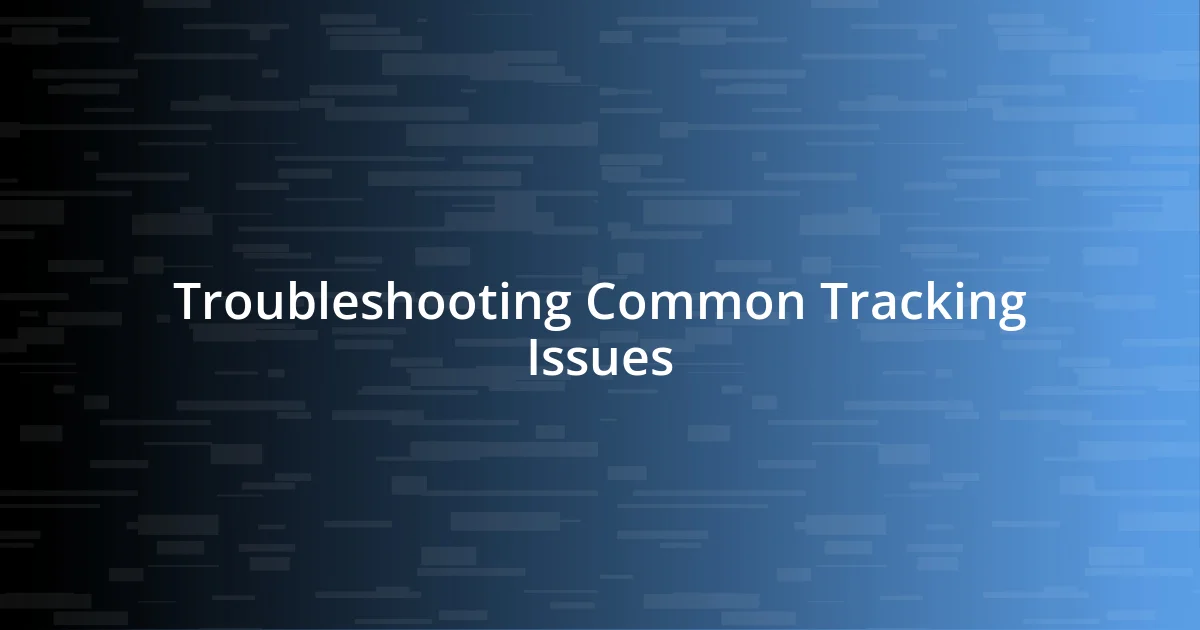Key takeaways:
- Tracking project tokens provides clarity and motivation, helping identify progress and bottlenecks in project management.
- Selecting the right tools and establishing a tailored token tracking system is crucial for effective project oversight and team collaboration.
- Regular documentation, transparency, and troubleshooting strategies are essential for maintaining accurate token tracking and addressing potential issues swiftly.

Understanding Project Tokens Tracking
Tracking project tokens is crucial for accurately assessing progress and resource allocation. I remember the first time I delved into token tracking for a project; it felt overwhelming. What surprised me the most was how effectively it transformed my approach to managing tasks and timelines.
When I began using a project management tool to keep tabs on tokens, it was like discovering a hidden treasure map. Each token represented a piece of progress or a task completed, giving me a visual representation of how far I’d come. I often ask myself: how can one number on a screen provide such clarity in the chaos of project management? It’s almost magical how these tokens help in spotting bottlenecks before they become critical issues.
Emotionally, tracking tokens can be a double-edged sword. While it fosters motivation through visible progress, I’ve also felt that pressure when deadlines loom. Have you ever felt that mixture of excitement and anxiety when you’re nearing the finish line? That’s why understanding this tracking system goes beyond mere numbers; it’s about recognizing the journey and the growth along the way.

Selecting Right Tools for Tracking
Selecting the right tools for tracking project tokens can drastically change your project management experience. In my own practice, I’ve experimented with various tools ranging from simple spreadsheets to comprehensive project management software. I still recall the time I transitioned from a basic tool to a more advanced one; the clarity and control I gained were revolutionary. Each click and entry felt purposeful, making me more confident in my tracking efforts.
When assessing your options, it’s essential to consider factors like ease of use, scalability, and integration with existing systems. I’ve found that tools that offer visual dashboards significantly enhance my ability to comprehend progress at a glance. For instance, a project management app with color-coded tokens not only helps in tracking but also adds an element of engagement to the mundane task of project oversight.
Moreover, I always recommend trial periods. Giving a new tool a test run can reveal its true value—or lack thereof. I remember being hesitant to commit to a subscription for a premium tool. After a trial, I realized it saved me hours each week, proving well worth the investment. Choosing the right tool is more than just preference; it’s about how it fits into your workflow and enhances your productivity over time.
| Tool | Features |
|---|---|
| Tool A | Visual dashboards, integrations, mobile access |
| Tool B | Simple interface, customizable reports, team collaboration |
| Tool C | Budget-friendly, basic tracking, limited support |

Setting Up Token Tracking Systems
Setting up token tracking systems requires careful consideration of your project’s unique needs. I remember when I first tailored a token tracking system for my team; it was like sculpting clay into a form that perfectly fit our workflow. I learned that starting with clear definitions for what each token represents is crucial. It creates a shared understanding among team members and aligns everyone toward common goals.
Here are some steps I recommend for optimizing your token tracking system:
- Define Token Types: Understand what each token signifies, such as tasks, milestones, or issues.
- Prioritize Visibility: Ensure your tracking system provides a clear overview, so everyone can see progress at a glance.
- Establish a Review Cadence: Regularly check-in on token progress to assess if adjustments in focus or resources are necessary.
- Encourage Feedback: Create an open forum for team members to suggest improvements or highlight concerns based on token tracking.
- Utilize Color Coding: This adds a layer of clarity, making it easier to identify completed tasks versus those that are pending.
In setting up your system, embracing an iterative approach can significantly enhance its effectiveness. I recall testing different arrangements and configurations, often adjusting on the fly. This flexibility allowed the system to evolve, reflecting the changing dynamics of my projects. It’s a journey, not a destination, and ensuring your tracking system evolves with your project team can lead to smarter resource management.

Best Practices for Managing Tokens
Managing project tokens effectively is crucial for keeping everything running smoothly. One best practice I’ve adopted involves setting strict guidelines on token ownership. For instance, assigning specific team members to own particular tokens fosters accountability. I’ve seen firsthand how this clear delineation significantly boosts team collaboration; everyone knows who to reach out to when they have questions or need updates on a specific task. Have you ever noticed how responsibility can drive performance? It’s a game-changer.
Another important aspect is to regularly communicate updates regarding the status of tokens. I learned this the hard way when I assumed everyone was on the same page after a major review. The subsequent project meeting revealed a maze of misunderstandings due to a lack of ongoing communication. In my experience, establishing a routine—be it a quick daily stand-up or a weekly roundup—helps everyone stay aligned. Trust me; that extra check-in can save you from unnecessary chaos later on.
Lastly, consider the power of analytics. I remember my surprise when I started digging into the data behind our token usage. It revealed patterns that pointed to bottlenecks and inefficiencies I hadn’t seen before. Using analytics not only informs future decisions but also helps justify resource allocation. Imagine being able to pinpoint exactly where to direct your efforts based on real insights! This data-driven approach has not only improved our tracking systems but also led to more informed project planning. When you prioritize these practices, managing tokens becomes less of a chore and more of a toolkit for success.

Analyzing Token Movement Trends
Analyzing token movement trends can unveil valuable insights about team dynamics and project pacing. I remember a time when I closely monitored the flow of tokens during a critical phase of a project. It felt like watching a well-choreographed dance; every movement, every pause, told a story. Patterns emerged that indicated our team wasn’t just busy but strategically productive. Have you ever mapped out your token flow and discovered hidden rhythms that gave you clarity? It can truly change the way you view your project timeline.
As I tracked these trends, I found that spikes in token movement often coincided with intense collaboration or looming deadlines. I distinctly recall a week when tokens skyrocketed, indicating a flurry of activity. That urgency fueled motivation, but it also exposed areas needing support. By identifying these trends, I was better equipped to allocate resources effectively. Isn’t it fascinating how something as simple as token movement can provide such a strong pulse on your team’s energy and focus?
Another key insight I gained is the importance of recognizing stagnant tokens. When I noticed tokens sitting idle for too long, it felt like a red flag waving at me. These moments pointed to potential roadblocks, miscommunications, or even disengagement within the team. Addressing these issues became a priority, as I learned they could snowball into larger problems. Have you ever let stale tokens linger too long? It’s eye-opening to realize how that small oversight can hinder overall progress. By consistently analyzing these patterns, I transformed my approach to project management, ensuring that each movement was purposeful and impactful.

Reporting and Documenting Token Data
Keeping meticulous records of token data has been a game changer for me. I remember a time when our project was moving so quickly that token documentation fell to the wayside. As a result, I found myself scrambling to retrieve essential information during a crucial meeting. It became clear that consistent reporting was non-negotiable. Now, I set aside dedicated time each week to review and document token statuses. This routine not only holds me accountable but also creates a reliable resource for my team.
When it comes to reporting, I’ve found that visual aids can make all the difference. During one project, I began using dashboards that visually represented token data alongside timelines. The moment I presented this at a project review, I saw my colleagues’ eyes light up with understanding. Those bright, bold visuals transcended jargon and offered clarity. Have you ever witnessed the impact of a well-designed report? It’s amazing how such simple changes can facilitate richer discussions and informed decision-making.
I also prioritize transparency in our documentation process. There was a point when access to token data was limited to only a few team members, creating bottlenecks and frustration. Once I opened up reporting channels and encouraged team members to contribute, I instantly noticed an uptick in engagement and collaboration. Sharing the responsibility not only alleviates pressure but cultivates a culture of shared ownership. How can we expect our projects to thrive if the information isn’t freely accessible? Embracing this collaborative approach truly transformed my team’s dynamic, leading us to tackle challenges proactively.

Troubleshooting Common Tracking Issues
When troubleshooting common tracking issues, the first step is to pinpoint where the breakdown occurs. I remember a time when I noticed discrepancies in token counts after a sprint. At first, it was perplexing—how could so much data be misaligned? I soon realized that miscommunication about who was responsible for updating the tokens led to the confusion. This taught me that clear ownership and regular check-ins can prevent such issues from arising.
Another common hiccup is the inconsistency in recording token data. I’ve been there—at the end of a long day, I’d rush to log everything, only to find myself second-guessing the accuracy later. How often have you felt that moment of dread? Implementing a quick review system with notifications has been a lifesaver for me. It keeps the team accountable and reduces those little errors that can snowball into bigger problems. Now, I know exactly who recorded what and when, which has added a layer of trust to our process.
Finally, don’t overlook the technical aspects of your tracking system. There was a crucial week when our token tracking software crashed, leaving us with limited visibility. It felt like being blindfolded during a major project milestone! I learned the hard way to schedule regular maintenance checks and have backup systems in place. Have you ever faced a situation where you could have avoided chaos with a simple precaution? Taking proactive steps to ensure your tools are functioning properly can save you a lot of stress and frustration down the line.














